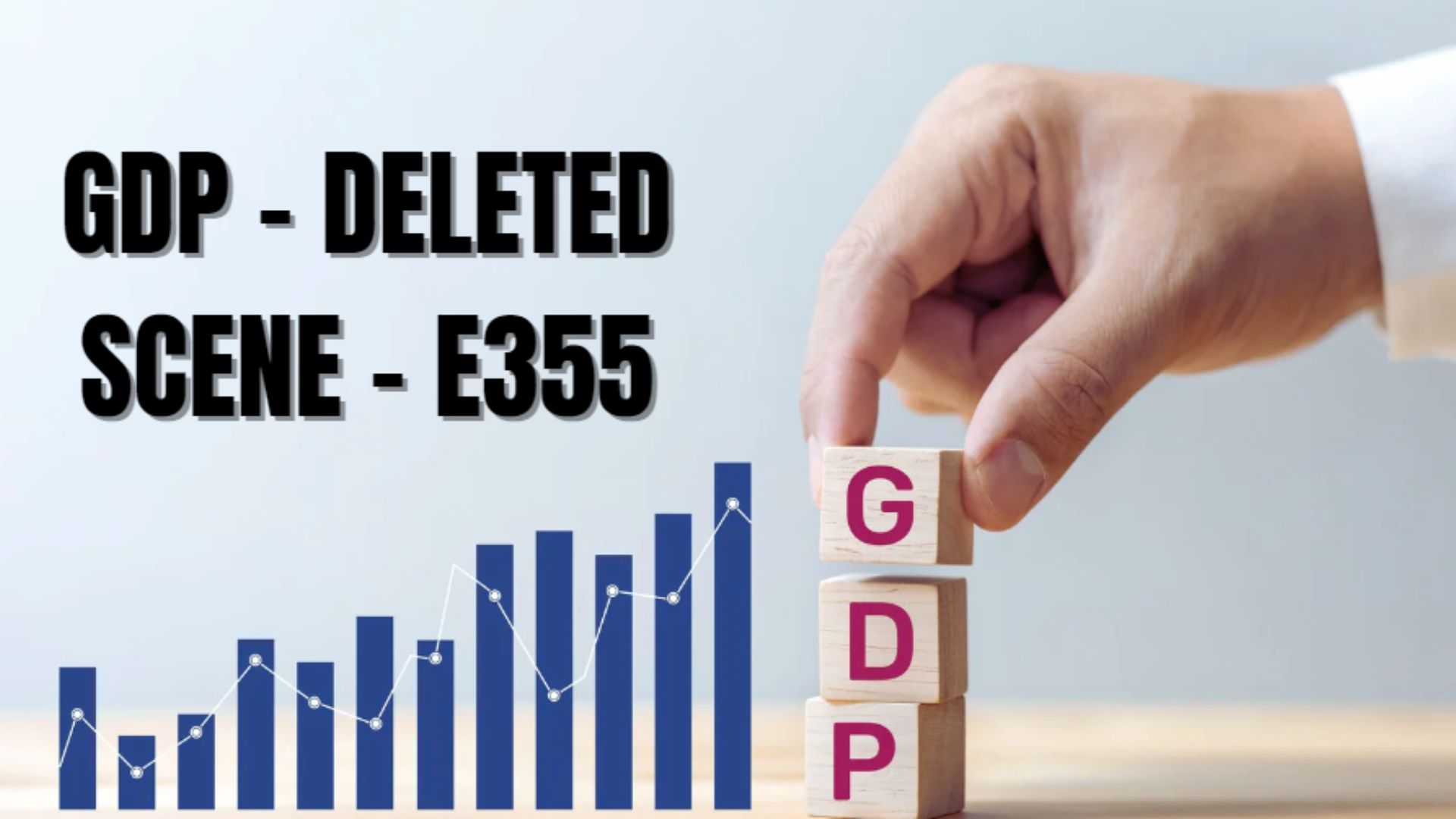The world of economics can seem complex and abstract, but at its core lies a powerful tool that shapes our understanding of growth: Gross Domestic Product, or GDP. It’s more than just numbers; it reflects the health and vitality of an economy. Recently, a fascinating twist in this narrative has emerged with the revelation of GDP – Deleted Scene – E355—a pivotal discovery that challenges how we view economic progress. This deleted scene from the often-revered GDP calculation tells a story not only about figures on paper but also about the impact these figures have on society as a whole. What does this mean for us? Let’s dive into what GDP – Deleted Scene – E355 is all about and explore how it could change everything we thought we knew about economic measurement.
Conclusion: The importance of staying informed on economic changes and their effects on society
Staying informed about economic changes is crucial for everyone, not just economists. Our daily lives are intricately tied to the health of the economy, from job security to inflation rates.
Understanding GDP and its evolving calculations allows us to grasp how policies and discoveries like the GDP – Deleted Scene – E355 affect our communities. Informed citizens can advocate for better governance and demand transparency in economic reporting.
Moreover, being aware of these shifts empowers individuals to make smarter financial decisions—be it investing or spending wisely. It creates a ripple effect that influences businesses and policymakers alike.
When society engages with economic data, we foster resilience against potential crises. Knowledge equips us with tools to navigate uncertainty while promoting growth that benefits all layers of society. The dialogue surrounding economics should be inclusive because when we understand these concepts collectively, we enhance our chances for meaningful progress.
Introduction to the GDP (Gross Domestic Product)
Gross Domestic Product, or GDP, is a crucial economic indicator. It represents the total value of all goods and services produced within a country over a specific period.
GDP helps gauge the health of an economy. When it rises, it often indicates growth and prosperity. Conversely, a decline signals potential troubles ahead.
There are three primary ways to measure GDP: production, income, and expenditure approaches. Each method offers unique insights into economic performance.
Understanding GDP can empower citizens and policymakers alike. It influences decisions on spending, investment, and social programs.
Despite its importance, GDP has limitations. Critics argue that it doesn’t capture well-being or environmental sustainability adequately.
As we explore further layers of this topic—particularly with respect to the GDP – Deleted Scene – E355—we can grasp how such elements alter our perception of economic math significantly.
E355: A Game-Changing Discovery
E355, a seemingly innocuous chemical compound, has emerged as a pivotal discovery in the realm of economic measurement. Its inclusion in GDP calculations is sparking significant debate among economists and policymakers alike.
This additive, commonly found in food products and other consumer goods, can dramatically influence market dynamics. By recognizing E355’s value and impact on consumption patterns, analysts are beginning to understand how such elements contribute to overall economic health.
The implications extend beyond mere numbers. Understanding E355 allows for more accurate assessments of consumer behavior. This could lead to refined policies that better reflect societal needs.
As researchers continue to delve into the nuances of this compound, its role in shaping economic narratives becomes increasingly clear. The conversation surrounding E355 challenges traditional views of growth and prosperity within our economies.
The Deleted Scene: What Was Left Out of the Original GDP Calculation
The original GDP calculation has long been viewed as the gold standard for measuring economic health. However, it left out a crucial aspect: the GDP – Deleted Scene – E355.
E355 represents an evolving sector that captures various informal and digital economic activities. It shines a light on contributions from gig workers, freelancers, and even unpaid domestic labor. All this was previously unaccounted for in traditional GDP figures.
Without including E355, the GDP fails to provide a complete picture of societal productivity and well-being. This omission skews our understanding of real growth versus mere financial transactions.
This deleted scene highlights how important it is to adapt our economic metrics as society changes. In doing so, we can better gauge the true impact of all contributors within our economy—both seen and unseen.
The Impact of Including E355 in the GDP
The inclusion of E355 in the GDP calculation has sparked significant debate among economists. This game-changing discovery could alter our perception of economic health.
By adding E355, we gain a more holistic view of an economy’s performance. Traditional GDP metrics often overlook certain sectors that contribute to societal well-being and financial stability. With this addition, policymakers can better understand real growth trends.
Moreover, it might influence how governments allocate resources. A broader GDP may lead to increased funding for underrepresented areas in the economy, such as environmental sustainability or social welfare programs.
However, there are concerns about relying too heavily on this new metric. Critics point out potential distortions in understanding true economic conditions. Balancing traditional measures with innovative approaches like E355 will be crucial moving forward.
Criticisms and Controversies Surrounding E355 and the GDP
The introduction of E355 into GDP calculations has stirred considerable debate. Critics argue it skews economic realities. They claim that by including this new metric, we potentially inflate growth figures, masking underlying issues.
Some economists fear that focusing on E355 might overshadow traditional indicators. Employment rates and income distribution could become secondary concerns in the quest for higher numbers.
Furthermore, there’s skepticism about how accurately E355 reflects societal well-being. Does a spike in GDP mean people are thriving? Many believe it doesn’t capture quality of life essentials.
Political ramifications also add to the controversy. Policymakers may manipulate these figures to justify decisions or gain public favor. The stakes are high when GDP becomes a tool for political agendas rather than an objective measure of economic health.
This ongoing discourse highlights the need for transparency and rigorous scrutiny in economic reporting practices as society continues to adapt to changing measurements like E355.
Alternative Measures of Economic Progress
As the conversation around GDP evolves, alternative measures of economic progress gain traction. These metrics aim to paint a fuller picture of societal well-being and sustainability.
The Human Development Index (HDI) is one such measure. It takes into account life expectancy, education level, and income. This holistic view highlights human welfare over mere financial output.
Another noteworthy approach is the Genuine Progress Indicator (GPI). GPI adjusts traditional economic data by including factors like environmental health and social inequality. This creates a more comprehensive understanding of prosperity.
Sustainable development goals also offer frameworks for evaluating progress beyond GDP. They prioritize ecological balance alongside economic growth, emphasizing long-term viability over short-term gains.
These alternative indicators push us to rethink what success looks like in our economies, urging policymakers to consider quality of life as much as quantity of production.
Conclusion: What Does This Mean for Our Understanding of Economic Growth?
Understanding the implications of GDP, especially with revelations like E355, can significantly alter our perception of economic growth. The inclusion of previously omitted elements provides a more nuanced view. It may challenge long-held beliefs about what drives an economy.
As we navigate through these changes, it becomes increasingly clear that staying informed is crucial. Economic indicators shape policies that affect daily life—jobs, wages, and overall prosperity hinge on these numbers.
The discussions around alternative measures highlight the need for comprehensive evaluations beyond traditional metrics. They remind us that while GDP has its place in assessing economic health, it isn’t the sole indicator of societal progress.
Recognizing shifts like E355 helps to broaden our understanding of economics as a dynamic field influenced by various factors. This evolving perspective encourages ongoing dialogue about how best to measure and understand true economic performance in modern society.





